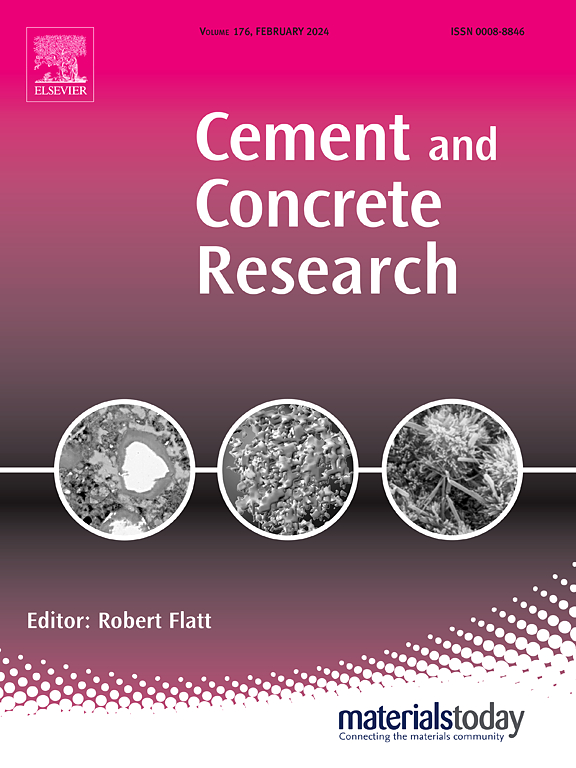HEMC修饰硅酸三钙水化:通过时间分辨高能x射线散射检测动力学和纳米结构的变化
IF 13.1
1区 工程技术
Q1 CONSTRUCTION & BUILDING TECHNOLOGY
引用次数: 0
摘要
羟乙基甲基纤维素醚(HEMCs)因其改变水泥体系流变学和和易性的能力而越来越受到关注,最重要的是随着水泥工业自动化程度的提高。本文采用量热法、高能x射线散射和扫描电子显微镜(SEM)研究了两种分子质量相近但取代度不同的HEMCs (DS)和摩尔取代度不同)对硅酸三钙(C3S)水化反应的影响。HEMCs降低了C3S的二次溶解速率,延缓了水化产物的析出。与DS和MS值无关,未添加HEMC的对照样品中C3S的溶出率比添加HEMC质量比为0.2和0.45%的样品高~ 20%和~ 13%。对于DS较低的HEMC2,波特兰降水被强烈延迟。本文认为,HEMCs在水合颗粒和无水C3S表面的相互作用/吸附可能是其早期水合作用的主要来源。原位x射线对分布函数(PDF)分析表明,在研究期间,与对照样品相比,C-S-H中的原子顺序没有变化,这表明相互作用发生在相的表面。HEMC2优先抑制C-S-H的形成/生长,而HEMC1对C-S-H几乎没有影响。在hemc修饰和对照膏体中出现了不同形态的波特兰石晶体。HEMC1抑制晶体沿[001]生长,这是由于它们在(001)面上的优先相互作用/吸附。在含有HEMC1的糊体中,HEMC聚合物的桥/膜在波特兰岩的堆叠层和C-S-H之间形成。本文章由计算机程序翻译,如有差异,请以英文原文为准。
HEMC modifications to tricalcium silicate hydration: Changes in kinetics and nanostructure examined by time-resolved high energy X-ray scattering
Hydroxyethyl methyl cellulose ethers (HEMCs) are of increasing interest for their ability to modify rheology and workability of cementitious systems and most importantly with the increase in automation in cement industry. In this paper, the effect of two HEMCs - with similar molecular masses but different degrees of substitution (DS) and molar substitution (MS) - on the hydration of tricalcium silicate (C3S) was examined by calorimetry, high energy X-ray scattering, and SEM up to 48 hours. The HEMCs decreased the secondary dissolution rate of C3S and delayed the precipitation of hydration products. The dissolution rate of C3S in the control sample, with no added HEMC, was ∼20 % and ∼ 13 % higher than that for samples with 0.2 and 0.45 % by mass of added HEMC, regardless of the DS and MS values. Portlandite precipitation was strongly delayed for the HEMC2 with the lower DS. It is proposed that interaction/adsorption of the HEMCs onto the surface of both hydrated particles and anhydrous C3S is likely the primary source of their action in early hydration. In-situ X-ray pair distribution function (PDF) analysis of HEMC-modified pastes revealed that the atomic ordering in the C-S-H was unchanged when compared to the control sample over the period studied, thus suggesting that the interaction occurs on the surface of the phase. It is proposed that HEMC2 preferentially inhibits the formation/growth of C-S-H, whereas HEMC1 shows almost no impact on C-S-H. Portlandite crystals with differing morphologies occurred in the HEMC-modified and control pastes. HEMC1 inhibits crystal growth along [001] due to their preferential interaction/adsorption on (001) faces. HEMC polymer bridge/film formation was observed between the stacked layers of portlandite and on C-S-H in pastes containing HEMC1.
求助全文
通过发布文献求助,成功后即可免费获取论文全文。
去求助
来源期刊

Cement and Concrete Research
工程技术-材料科学:综合
CiteScore
20.90
自引率
12.30%
发文量
318
审稿时长
53 days
期刊介绍:
Cement and Concrete Research is dedicated to publishing top-notch research on the materials science and engineering of cement, cement composites, mortars, concrete, and related materials incorporating cement or other mineral binders. The journal prioritizes reporting significant findings in research on the properties and performance of cementitious materials. It also covers novel experimental techniques, the latest analytical and modeling methods, examination and diagnosis of actual cement and concrete structures, and the exploration of potential improvements in materials.
 求助内容:
求助内容: 应助结果提醒方式:
应助结果提醒方式:


